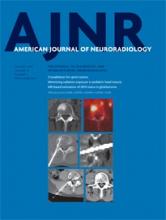We wish to comment on the August 2015 article of Adin et al1 in the American Journal of Neuroradiology (AJNR) entitled “Hyperintense Dentate Nuclei on T1-Weighted MRI: Relation to Repeat Gadolinium Administration.” The authors reported the relationship between the hyperintense dentate nucleus on unenhanced T1WI and past gadolinium based–contrast agent (GBCA) administration. This relationship was first reported by our group on December 7, 2013.2 Since then, several important reports have been published, and knowledge regarding gadolinium deposition has increased remarkably.
Our group3 and Radbruch et al4 evaluated the difference in the signal change between patients repeatedly administered linear GBCA and macrocyclic GBCA. A change in the signal intensity of the dentate nucleus was observed in the former, but not in the latter. McDonald et al5 and our group6 evaluated the brain tissue from postmortem specimens, and gadolinium deposition was verified from the brain tissue.7 Robert et al8 injected GBCA 20 times into rats and evaluated the signal-intensity change of the dentate nucleus on T1WI and gadolinium concentration in the brain. A hyperintense dentate nucleus was observed in rats with repeat linear GBCA administration, but not with repeat macrocyclic GBCA administration. The gadolinium concentration of the brain with repeat linear GBCA administration was 14 times greater than that with repeat macrocyclic GBCA administration.8 The work of Adin et al1 was confirmed in our first study. It was accepted by AJNR on February 19, 2015, and was published on-line on August 20, 2015. In this short period, studies on gadolinium deposition advance so rapidly, a more prompt publication schedule from AJNR would be desirable.
In previous studies (our study), a hyperintense dentate nucleus on T1WI was detected in subjects with >5 previous administrations of gadodiamide or gadopentetate dimeglumine. In contrast, in this study, some of the subjects with >12 previous administrations of GBCA did not show hyperintensity in the dentate nucleus. One reason may be the use of macrocyclic GBCAs in these subjects. In addition, the detectability of the hyperintense dentate nucleus on various sequences of T1WI may have influenced their results. According to our experience with several cases, the detectability of high signal intensity in the dentate nucleus differs between spin-echo T1WI and T1 FLAIR (Fig 1). Adin et al1 evaluated the hyperintense dentate nucleus with various T1WI sequences, such as MPRAGE, spin-echo, and T1 FLAIR. The different detectabilities of hyperintense dentate nuclei on these sequences may have influenced their results.
Images in a 41-year-old woman with a history of malignant lymphoma and 7 administrations of gadopentetate dimeglumine. The dentate nucleus is hyperintense on spin-echo T1WI (A), but not on T1 FLAIR (B).
Indicates open access to non-subscribers at www.ajnr.org
References
- © 2016 by American Journal of Neuroradiology








